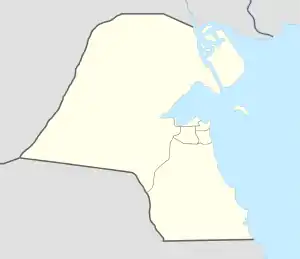Kazma
Kazma (Arabic: كاظمة) is an ancient city in Kuwait. It is located in Al Jahra Governorate, 40 km (25 mi) north of Kuwait City, the capital of Kuwait. It is an ancient city with a long history, known to Persians and Arabs since the Sassanid, Jahiliyyah and the early Islamic eras.
 Shown within Kuwait  Kazma (Near East) | |
| Location | Kuwait |
|---|---|
| Region | Eastern Arabia |
| Coordinates | 29.392881°N 47.671255°E(approximate) |
History
In 633 AD, the Battle of Chains between the Sassanid Empire and Rashidun Caliphate was fought in Kuwait near Kazma.[1][2] At the time, Kuwait was under the control of the Sassanid Empire. The Battle of Chains was the first battle of the Rashidun Caliphate in which the Muslim army sought to extend its frontiers.
As a result of Rashidun victory in 633 AD, the bay of Kuwait was home to the city of Kazma (also known as "Kadhima" or "Kāzimah") in the early Islamic era.[2][3][4][5][6][7][8] Medieval Arabic sources contain multiple references to the bay of Kuwait in the early Islamic period.[7][8][9] The city functioned as a trade port and resting place for pilgrims on their way from Iraq to Hejaz. The city was controlled by the kingdom of Al-Hirah in Iraq.[7][10][11] In the early Islamic period, the bay of Kuwait was known for being a fertile area.[2][12][13]
The Kuwaiti city of Kazma was a stop for caravans coming from Persia and Mesopotamia en route to the Arabian Peninsula. The poet Al-Farazdaq was born in the Kuwaiti city of Kazma.[14] Al-Farazdaq is recognized as one of the greatest classical poets of the Arabs.[14]
See also
References
- Kurt Ray (2003). A Historical Atlas of Kuwait. The Rosen Publishing Group, Inc. pp. 10. ISBN 9780823939817.
- Dipiazza, Francesca Davis (2008). Kuwait in Pictures. pp. 20–21. ISBN 9780822565895.
- Brian Ulrich. "Kāzimah remembered: historical traditions of an early Islamic settlement by Kuwait Bay". British Museum, Seminar for Arabian Studies.
- Kennet, Derek. "Investigating an Early Islamic Landscape on Kuwait Bay: the archaeology of historical Kadhima". Durham University.
- Maguer-Gillon, Sterenn Le; Ulrich, Brian; Kennet, Derek. "Kadhima: Kuwait in the early centuries of Islam". academia.edu.
- "The Soft stone from Kadhima: evidence for trade connections and domestic activities". Kuwait NCCAL, Durham University.
- Brian Ulrich (January 2013). "From Iraq to the Hijaz in the Early Islamic Period: History and Archaeology of the Basran Hajj Road and the Way(s) through Kuwait". The Hajj: Collected Essays, ed. Venetia Porter and Liana Saif.
- Kennet, Derek; Blair, Andrew; Ulrich, Brian; Al-Duwīsh, Sultan M. (2011). "The Kadhima Project: investigating an Early Islamic settlement and landscape on Kuwait Bay". Proceedings of the Seminar for Arabian Studies. jstor.org. 41: 161–172. JSTOR 41622130.
- "Kāzimah". academia.edu.
- Proceedings of the Seminar for Arabian Studies Volumes 9–12. 1979. p. 53.
Although the town of al-Hira might have been too far northward to be considered a part of Eastern Arabia it is dealt with here as such because the kingdom of al- Hira controlled Kazima (Kuwait).
- "New field work at Kadhima (Kuwait) and the archaeology of the Early Islamic period in Eastern Arabia". SOAS. Archived from the original on 2018-11-25. Retrieved 2021-08-14.
- "Culture in rehabilitation: from competency to proficiency". Jeffrey L. Crabtree, Abdul Matin Royeen. 2006. p. 194.
During the early Islamic period, Kazima had become a very famous fertile area and served as a trading stations for travelers in the region.
- "Kadhima : an Early Islamic settlement and landscape on Kuwait Bay". Durham University. Archived from the original on 2013-10-19. Retrieved 2013-07-28.
- "Farazdaq center lauds Info. Min. care for youth". Kuwait News Agency. 22 May 2014.